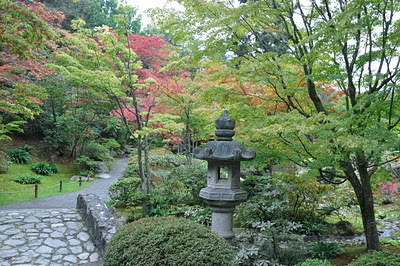11/6/11 Edit: added a few pics to show how the fall maple color progressed
(click on the pics to see them large)
Last week I went to the Garden and recorded all the displayed maples to share with the world, and here they are:
 |
| SJG • 10/19/11 Koto-no-ito |
The one in the pic on the left, as well as the one on the East path of the Garden are still rather completely green. The one on the West path, close to the moon-viewing platform is quite orange and red. Koto-no-itos reside in areas A, F and V.
And here is the colorful one and its leaves:
 |
| SJG • 10/19/11 - Koto-no-ito |
 |
| SJG • 10/19/11 - Acer palmatum Koto-no-ito leaves |
2.) Acer palmatum 'Inazuma' - Keiko informed me that Inazuma means 'lightning' in Japanese (soon Keiko and I will write a communal post about certain maples and their names):
 |
| SJG • 10/19/11 - Acer Palmatum 'Inazuma' near the entrance gate. It's the biggest brown mass, right above a small something in the foreground (I should have asked Tony to take the pics:( ) |
 |
| SJG • 11/1/11 - The same Acer Palmatum 'Inazuma' 2 weeks later; the small 'something' in the foreground turned out acer palmatum dissectum, here already in nearly bye-bye stage. |
 |
| SJG • 10/19/11 - Acer Palmatum 'Inazuma' leaves |
3.) Acer palmatum 'Sango-Kaku', Japanese coral bark maple:
It also lives near the Garden entrance, a few steps north of Inazuma. You may not notice it immediately, because it sits closer to the fence than the path.
 |
| SJG • 10/19/11 - Acer palmatum 'Sango-Kaku', Japanese coral bark maple; it the one non-green color in the pic, towards the fence, Area C |
 |
| SJG • 10/19/11 - Acer palmatum 'Sango-Kaku', Japanese coral bark maple; bark and leaves |
4.) Acer palmatum dissectum, Japanese lace leaf maple:
There is one in areas B, C and Y. I never noticed the one in Y, but the ones in B and C usually are mentioned right at the beginning of the tours, because they are both close to the entrance and both about 100 years old - these specimens grow very slow, so they were already quite mature when set in the Garden 50 years ago - now one of the crown jewels.
 |
| SJG • 11/1/11 - The same Acer palmatum dissectum, Japanese lace leaf maple. 2 weeks later, now in true fall color |
 |
| SJG • 10/19/11 - Acer palmatum dissectum, Japanese lace leaf maple |
5.) Acer japonicum vitifolium, Japanese full-moon maple:
There are two of them, kind of kiddy corner from each other, not far from the entrance, in the areas C and Z, facing the path from opposite sides. Actually, only one of maples was marked, so when Keiko asked if the other is a 'full moon' I answered 'no', because at the first glance they didn't even look similar to me: one bright red into almost black on the edges, the other a variety of vibrant hues of orange, red, yellow and even some green still. Fortunately Keiko didn't believe me and checked the plant book; surely enough they were both full moon maples, again each doing their own (scientifically = yeah, you guessed it: I don't know what I'm talking about ) different stuff.
 |
| SJG • 10/19/11 - 5.) Acer japonicum vitifolium, Japanese full moon maple, leaves. |
6.) Acer capillipes, stripped-bark maple:
When Forest and I went to look for it in area M we couldn't find it, fortunately Marilyn knew where the one in area Z is (several of us, guides, were waiting for a school bus that got stuck on 520-bridge and we were passing the time re-uniting the labels with the maples). Now it became apparent why we couldn't locate the first one: they look nothing like a typical maple, and both specimens are quite large trees, with much bigger than many dainty Japanese maples trunks (YES, green stripped) and leaves you'd probably not guess being maples.
 |
| SJG 10/19/11 - Acer capillipes, stripped-bark maple |
 |
| SJG 10/19/11 - Acer capillipes, stripped-bark maple leaves. You can see that the leaves higher up, above the other tree level turned already, while the leaves on the lower branches are still green. |
7.) Acer palmatum "Burgundy Lace', Japanese maple:
 |
| SJG • 10/19/11 - Acer palmatum "Burgundy Lace', Japanese maple |
 |
| SJG • 10/19/11 - Acer palmatum "Burgundy Lace', Japanese maple leaves |
•••••••••••••
Part 2 of this Maple Fest post coming tomorrow... Now I'll finish with gratuitous pic of the burning bush, just because it looks stunning:
 |
| SJG • 10/19/11 - The burning bush is trained like a tree above what I think is some sort of azalea |











